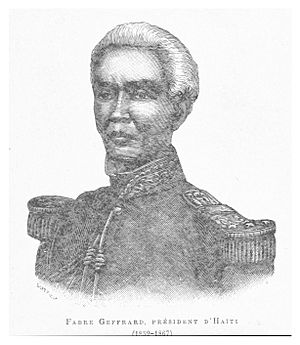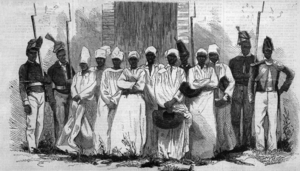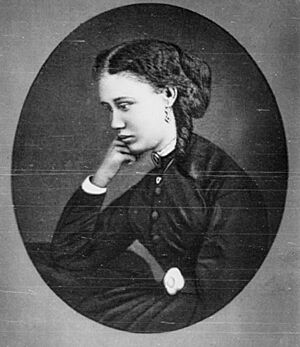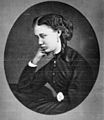Fabre Geffrard facts for kids
Quick facts for kids
Fabre-Nicolas Geffrard
|
|
|---|---|
 |
|
| 8th President of Haiti | |
| In office 15 January 1859 – 13 March 1867 |
|
| Preceded by | Faustin I of Haiti (as Emperor of Haiti) |
| Succeeded by | Nissage Saget (provisional) |
| Personal details | |
| Born |
Guillaume Fabre Nicolas Geffrard
23 September 1806 Anse-à-Veau, Haiti |
| Died | 31 December 1878 (aged 72) Kingston, British Jamaica |
| Spouse | Marguerite Lorvana McIntosh |
| Profession | Military |
Guillaume Fabre Nicolas Geffrard (born September 23, 1806 – died December 31, 1878) was a Haitian general. He became the President of Haiti in 1859 and served until 1867.
Before becoming president, Geffrard was a key figure in the Haitian army. He helped remove Emperor Faustin Soulouque from power. As president, he worked to improve education and made peace with the Roman Catholic Church. He faced several challenges and rebellions during his time in office. In 1867, he was eventually removed from power by Major Sylvain Salnave.
Contents
Fabre Geffrard's Early Life and Military Career
Fabre Geffrard was the son of Nicolas Geffrard, a general during the Haitian Revolution. His father was one of the people who signed the Haitian Declaration of Independence. Sadly, his father passed away a few months before Fabre was born. Fabre was then adopted by his uncle, Colonel Fabre.
Geffrard joined the army in 1821 after leaving college. In 1843, he joined General Charles Rivière-Hérard's rebellion against dictator Jean-Pierre Boyer. Geffrard was made a lieutenant-colonel. He won battles against Boyer's troops and was promoted to brigadier general in 1844.
Later, under Emperor Faustin Soulouque, Geffrard led troops in wars against the Dominican Republic. He became famous for his victory at La Tabarra in 1849. He also showed great skill in 1856 during the second war against Santo Domingo. For his military success, he was given the title Duke of Tabarre.
However, Emperor Faustin I became unpopular. Geffrard was arrested but managed to escape. He then organized a revolt that led to the fall of the Empire. On January 15, 1859, after Emperor Faustin I stepped down, Geffrard announced the Third Republic and was elected president.
Geffrard's Time as President of Haiti
One of Geffrard's first actions as president was to reduce the size of the army. He cut it in half, from 30,000 soldiers to 15,000. He also created his own special guards called Les Tirailleurs de la Garde. He trained these guards himself.
Improvements in Education and Infrastructure
In June 1859, President Geffrard started the National Law School. He also brought back the Medical School that had been started by Jean-Pierre Boyer. His education ministers worked to modernize and create many new high schools, called lycea. These new schools were built in cities like Jacmel, Jérémie, Saint-Marc, and Gonaïves.
Geffrard also focused on improving Haiti's roads. On October 10, 1863, he brought back an old law. This law required that roads be built and kept in good condition.
Encouraging Immigration and Economic Changes
Geffrard continued a policy of past leaders like Jean-Jacques Dessalines and Alexandre Pétion. He encouraged African Americans to move and settle in Haiti. For example, in May 1861, a group led by James Theodore Holly settled near Croix-des-Bouquets.
In 1863, Geffrard also changed Haiti's money system to be more like modern systems. Haiti also became a major exporter of cotton to the United States during the American Civil War. Geffrard brought in machines and experts to help grow more cotton. However, the cotton crops failed in 1865 and 1866.
Religious Policies and the Affaire de Bizoton
Geffrard was a Catholic. He did not support the practice of Voodoo. He ordered that Voodoo altars, drums, and other items used in ceremonies be destroyed.
In 1863, a young girl was believed to have been killed by Voodoo practitioners. Geffrard ordered a thorough investigation. A public execution was held for those found guilty. This event became known as the famous Affaire de Bizoton.
Foreign Relations and the Dominican Republic
In 1859, Geffrard tried to negotiate with the Dominican Republic. However, in March 1861, the Dominican leader gave his country back to Spain. This made Haitian officials worried about a European power being so close to their border again.
When a rebellion against Spain broke out in Santo Domingo, Geffrard sent his guards to help the rebels. But in July 1861, Spain gave Haiti a strong warning. Geffrard agreed to stop helping the Dominican rebels. Many Haitians felt humiliated by this decision.
Support for Abolitionism in the United States
Geffrard strongly supported the movement to end slavery in the United States. He held a state funeral for John Brown, an abolitionist who was executed in 1859.
During the American Civil War, Haiti was officially recognized by the United States. Haiti became a friendly port for the United States Navy. The city of Cap-Haïtien became the headquarters for the US West Indian Squadron. This squadron helped block trade to the Southern states.
Challenges and Overthrow
President Geffrard faced many attempts to remove him from power.
Failed Coups Against Geffrard
Early in his presidency, in 1859, a plan to overthrow Geffrard was discovered. The person behind it, Guerrier Prophète, was sent away from Haiti. In September 1859, Geffrard's daughter, Cora Manneville-Blanfort, was sadly killed.
Several other attempts to overthrow Geffrard failed:
- In 1861, General Legros tried to take control of weapons but was stopped.
- In 1862, Etienne Salomon tried to start a revolt but was killed.
- In 1863, Aimé Legros gathered troops, but they turned against him, and he was shot.
- In 1864, a group in Port-au-Prince tried to seize weapons. The people involved were caught and sent to jail.
- Even Geffrard's own bodyguards, the Tirailleurs, tried to assassinate him in 1867.
Geffrard's Overthrow
In 1865, Major Sylvain Salnave began to take control of parts of northern Haiti. Geffrard's government troops clashed with Salnave's forces. The situation became very difficult for Geffrard, especially financially. His actions also caused problems between different regions of Haiti.
In 1866, a large fire destroyed many homes and businesses. Finally, in March 1867, Geffrard and his family disguised themselves and fled Haiti. They went to Jamaica, where he passed away in Kingston in 1878.
Geffrard's Family
Fabre Geffrard and his wife, Marguerite Lorvana McIntosh, had several children:
- Laurinska Madiou
- Celimene Cesvet
- Cora Manneville-Blandfort (died 1859)
- Marguerite Zéïla Geffrard
- Claire Geffrard
- Angèle Dupuy
- Charles Nicholas Clodomir Fabre Geffrard (1833-1859)
Images for kids
See also
 In Spanish: Fabre Geffrard para niños
In Spanish: Fabre Geffrard para niños





